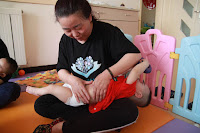Many of the children in our program have physical scars. And for many of these children, their scars represent one or more life-saving surgeries. A scar down the front of one child’s chest represents open heart surgery to repair a septal defect… a scar across another one’s abdomen represents a previous colostomy and subsequent reversal for anal atresia. Ying and Cheng are just two children who have physical scars from their life-saving surgeries.


Scars are a normal part of the wound healing process and can be a reminder of a more critical period in a child’s medical history. Interestingly, scars can take up to 2 years to fully mature.
For infants and young children with a lot of growing yet to do, the mobility of a scar can be critical too. Scar mobility (or lack thereof) can further impact a child’s overall growth and development. Surgical scars run deep and scar tissue can adhere to any underlying structures– connective tissue, muscles, tendons, blood vessels, nerves, organs, and bones. These adhesions can restrict movement and function. Scars can also be hypersensitive to touch, producing visceral responses (nausea/vomiting) in the most extreme situations. Scars obtained in infancy/early childhood can negatively impact various body systems (musculoskeletal- posture, cardiopulmonary- breathing, internal organs- digestion, etc.) as children continue to grow.
Recently we did a scar management training with the nannies in one of our baby homes. We had the opportunity to look at different children’s scars, assess their mobility, and demonstrate how to perform scar massage to prevent complicating adhesions. We can’t remove the scars from these children or change their past medical history, but we can help ensure these scars won’t further impair movement and function as they continue to grow and develop.








No comments:
Post a Comment